Round The World and other travels
A frequent flyer's collection of trip diaries
This is: A Taste of the Deep South (2013)
Soldiers and trains - a boys' day out!
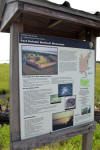
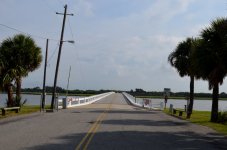 My 'recovery sleep' worked this time and I was
happy to get up fairly early, as planned. We had breakfast at the
hotel and found it to be really busy. Today's plan called for a
morning visit to a couple of out-of-town points of interest, this
ability of course being one of the great advantages of having a car
available. The first stop was to be Fort Pulaski, a national
monument in the care of the excellent US National Park Service,
situated some 15 miles away on Cockspur Island in the Savannah
River, just south of the state line with South Carolina. We wanted
to get there ahead of the crowds if possible and managed to arrive
not too long after the 9am opening time. The place was fairly empty
at that time, apart from one especially eager group of boy scouts,
but it wouldn't be long before the tour buses were rolling in.
My 'recovery sleep' worked this time and I was
happy to get up fairly early, as planned. We had breakfast at the
hotel and found it to be really busy. Today's plan called for a
morning visit to a couple of out-of-town points of interest, this
ability of course being one of the great advantages of having a car
available. The first stop was to be Fort Pulaski, a national
monument in the care of the excellent US National Park Service,
situated some 15 miles away on Cockspur Island in the Savannah
River, just south of the state line with South Carolina. We wanted
to get there ahead of the crowds if possible and managed to arrive
not too long after the 9am opening time. The place was fairly empty
at that time, apart from one especially eager group of boy scouts,
but it wouldn't be long before the tour buses were rolling in.
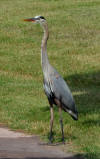 The fort was built between 1829 and 1833 in
order to defend the city of Savannah against possible foreign
attack. It was named after Kazimierz Pulaski (his first name became
anglicised as Casimir), a Polish nobleman and soldier who emigrated
to North America to fight in the War of Independence and ended up
saving the
life of George Washington as part of his efforts. The fate of Fort
Pulaski during the American Civil War proved to be a game changer in
the war itself and also in the wider world of defence. Union forces
surrounded the Confederate stronghold and, when their demands for
surrender were ignored, unleashed a barrage using new rifled cannon.
Masonry instantly became obsolete as a viable defence and the
ensuing blockade of Savannah harbour helped cripple the Confederacy.
The fort was built between 1829 and 1833 in
order to defend the city of Savannah against possible foreign
attack. It was named after Kazimierz Pulaski (his first name became
anglicised as Casimir), a Polish nobleman and soldier who emigrated
to North America to fight in the War of Independence and ended up
saving the
life of George Washington as part of his efforts. The fate of Fort
Pulaski during the American Civil War proved to be a game changer in
the war itself and also in the wider world of defence. Union forces
surrounded the Confederate stronghold and, when their demands for
surrender were ignored, unleashed a barrage using new rifled cannon.
Masonry instantly became obsolete as a viable defence and the
ensuing blockade of Savannah harbour helped cripple the Confederacy.
It proved to be an interesting and pleasant visit in the morning sunshine, despite our being constantly pestered by the local, supersize insect life!
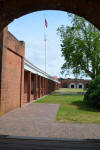 |
 |
 |
 |
 |
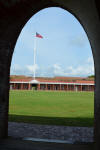 |
 |
 |
 |
 |
Retracing our route back towards Savannah to the tiny fishing village of Thunderbolt, we quickly located our next objective - the Bonaventure Cemetery. Located on the banks of the Wilmington River, it’s one of Savannah’s most unusual sights. John Muir wrote of Bonaventure’s Spanish moss-bedecked beauty in his 1867 book A Thousand Mile Walk to the Gulf. A number of signs reminding visitors to lock their cars and keep their valuables out of sight seemed a little out of place and provided something of a jolt back to the real world. It was searingly hot walking around in the full strength of the midday sun, but it was interesting to see so many opulent monuments, obelisks, Celtic crosses and significant numbers of Scottish and German names. The lush tree growth and the dangling Spanish moss provided plenty of atmosphere and, in spite of the burning sun, made me thankful that I was there in broad daylight.
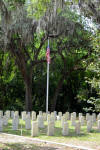 |
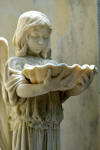 |
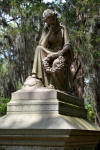 |
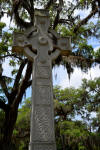 |
 |
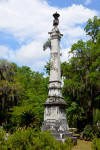 |

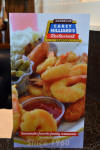 Today's
lunch plan was to have involved sampling some authentic soul food at a
restaurant called Sisters of the New South. There was only
one problem: despite several attempts, we simply couldn't find the
place!
Today's
lunch plan was to have involved sampling some authentic soul food at a
restaurant called Sisters of the New South. There was only
one problem: despite several attempts, we simply couldn't find the
place!
![]() We did, however spot a popular alternative by the name of Carey
Hilliard's and, going by the maxim that a busy parking lot is
usually a good sign, we decided to give it a whirl. The restaurant
had a family atmosphere and what was instantly noticeable was that
most customers had obviously come straight from church, beautifully
turned out in their Sunday-best attire - a concept familiar to me as
a child, but which has all but disappeared from European culture. We
had devilled crab, fried shrimp and hushpuppies (deep-fried cornmeal
balls). Of course you could almost predict the fact that we would
spot our original choice of eatery within five minutes of leaving,
but it had been a successful lunch stop and we had no real regrets.
Returning to base, we chilled for half an hour before moving on to
the next part of the day's agenda.
We did, however spot a popular alternative by the name of Carey
Hilliard's and, going by the maxim that a busy parking lot is
usually a good sign, we decided to give it a whirl. The restaurant
had a family atmosphere and what was instantly noticeable was that
most customers had obviously come straight from church, beautifully
turned out in their Sunday-best attire - a concept familiar to me as
a child, but which has all but disappeared from European culture. We
had devilled crab, fried shrimp and hushpuppies (deep-fried cornmeal
balls). Of course you could almost predict the fact that we would
spot our original choice of eatery within five minutes of leaving,
but it had been a successful lunch stop and we had no real regrets.
Returning to base, we chilled for half an hour before moving on to
the next part of the day's agenda.

 And
we certainly didn't have far to go! Just one (Savannah) block away
was the start of the Battlefield Park complex, which included the Georgia State Railroad Museum and the
And
we certainly didn't have far to go! Just one (Savannah) block away
was the start of the Battlefield Park complex, which included the Georgia State Railroad Museum and the
 Savannah
History Museum, the latter located in the former station building.
We started by having a brief look at the park itself. It certainly
occupies the site of a conflict during the War of Independence, but
there's nothing actually historical to see, as this is recovered
railway property. What was interesting - some might suggest
portentous - about the display was that the narrative referred to the
UK and Scotland as distinct entities.
Savannah
History Museum, the latter located in the former station building.
We started by having a brief look at the park itself. It certainly
occupies the site of a conflict during the War of Independence, but
there's nothing actually historical to see, as this is recovered
railway property. What was interesting - some might suggest
portentous - about the display was that the narrative referred to the
UK and Scotland as distinct entities.
Next, we moved on to the highly regarded Georgia State Railroad Museum. The museum's main feature was a working turntable and the surviving part of the so-called 'roundhouse' maintenance shed built around it. Constructed in 1830 for the new Central of Georgia Railroad, the design was cutting edge for its time. Other items of interest included rolling stock (from powerful locomotives to luxurious coaches to handcars!), workshops and rather touchingly, an attractive little workers' garden.
 |
 |
 |
 |
 |
 |
 Afterwards,
we had a wander through the public areas of the old station
building, but didn't go into the other museum housed there. It
started to rain at this stage, but of course we were almost on our
own doorstep. After a period of deserved relaxation following the
day's exertions, we had dinner at the Mellow Mushroom, which was a
young and 'studenty' place with a good vibe. We ordered a couple of
great pizzas and shared them.
Afterwards,
we had a wander through the public areas of the old station
building, but didn't go into the other museum housed there. It
started to rain at this stage, but of course we were almost on our
own doorstep. After a period of deserved relaxation following the
day's exertions, we had dinner at the Mellow Mushroom, which was a
young and 'studenty' place with a good vibe. We ordered a couple of
great pizzas and shared them.